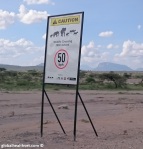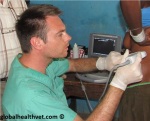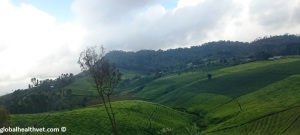Hi everyone!
Before starting any health intervention, one of the most important things to do is to figure out if an intervention is needed at all and if so, what it should focus on. Part of that comes from doing a needs assessment.

A true One Health situation – Samburu National Park has no barriers, leading to increased interactions between wildlife, livestock and humans
Looking through a broad lens – we may come to understand a lot about a specific health issue (e.g. how a disease is maintained in the environment, what are symptoms, etc.). However, all this knowledge may be useless if we cannot implement interventions that will work at a local level. Last December, I had the opportunity participate in a needs assessment activity in Kenya, which was a great way to learn more about One Health in East Africa.
Refining the problem. As much as possible, a needs assessment must be done locally. This is the opportunity to understand how local culture relate to the issue at hand. It can help identify additional risk factors as well as a specific group of people who are most affected by the problem. Eventually, it will feed into intervention-based projects to ensure that we don’t “miss the target” and truly use resources where needed.
Culturally relevant interventions. Going beyond understanding a problem locally, meeting with the affected population gives the opportunity to get feedback from them. Promoting healthy behaviors is an integral part of improving health. However, this may be very difficult if the proposed behaviors are not compatible with local cultural practices. Answering the following questions is essential to implementing long-lasting interventions:
- What does the affected population perceive as health concerns? Should we be focusing on a different problem?
- What interventions have failed to promote change in the past? Why did they not succeed?
- What are barriers to enacting interventions? These may be cultural, logistical, political or more.
- What could be solutions to overcome these barriers?
- What are best ways to successfully convey health messages or education to local population (e.g. radio, town meetings, flyer or other activity) and who should receive those messages?
A Knowledge Attitude Practice (KAP) survey is a great tool to get some of the answers above.

Hydatid cyst disease life cycle posters at a health screening clinic set up in a school
Identifying local partners and stakeholders. Chances are, other organizations are working on similar issues. They may be local government, non-profits and/or international organizations. Finding what others are doing in regards to a specific problem is essential to making sure that there is no duplication of efforts. Improving global health should be done through a collaborative process, rather than multiple organizations working on their own. In addition, identifying local leaders who will be on board with proposed interventions is crucial to the success of a health campaign.
There is obviously much more to needs assessments and the parts described above are my take on what are its most essential aspects. Other resources exist that describe this process in much more detail and I encourage the reader to do their own research. I have included some additional resources at the end of this post.
Our first step in Kenya was to meet local organizations. They included the Faculty of Veterinary Medicine at the University of Nairobi, the OIE Sub-Regional Office for East Africa, government veterinarians, representative from SIDAI – a local veterinary service provider –, and the Meru University of Science and Technology (MUST), our main host for the trip.
Through our discussions with stakeholders, we got a better insight of local One Health efforts and our meetings with these groups focused our project ideas.
With our colleagues from MUST, we then started our field visits to understand the roles of animals in Kenya and the challenges related to human-animal-environment interactions. Site visits included: dairy farms, slaughterhouses, local villages and more.
Kenya is very diverse, both in its geographical landscape and richness of cultures. It was evident that people’s interactions with animals were vastly differed based on location and predominant culture represented. For example, in the green hills of tea-producing Meru County, dairy farming is predominant. Just over an hour away, in the dryer Samburu County, pastoralism is more common. The challenges in each therefore reflect their local environment and practices. For example, pastoralist communities may travel over large distances during the year, looking for grazing areas for their herds (mostly small ruminants and cattle), whereas the dairy farmers we visited were more established.
In an area where people’s livelihoods are intricately linked to animals, a One Health perspective is essential to understanding current health issues – and prepare for future ones. This was evident as the concerns over the upcoming El Niño were high, especially in the dry Samburu region. Pastoralists were worried about the environmental impact of the weather phenomenon and whether it will bring more drought to the region.
Because of the Samburu pastoralist lifestyle, access to medical care (for animals and people) was not always easy. Pastoralist villages may be far from

I also had the opportunity to help at an ultrasound health assessment – specifically looking for hydatid cysts
larger towns with health centers and, in case of emergencies (such as complications from pregnancy), people may have to walk for several days before getting to a place where they can be treated. The same goes of animal health; a disease outbreak affecting livestock can potentially devastate a herd (and people’s livelihoods) before it can be managed.
Finally, it was interesting to notice that, in most of the slaughterhouses we visited, there was good knowledge of what carcasses should be condemnable (i.e. not fit for human consumption due to likely infection with zoonotic pathogens). Specific understanding about how zoonotic diseases infect humans was not as common however. This is not unexpected, however recognizing disease is only one aspect of efficient disease prevention. To truly reduce the impact of zoonoses, a basic understanding of their life cycle is essential. This may be an area of emphasis for future educational messages.
We learned a lot more from our visit and contact with local communities, which enabled us to further define our future projects. We hope that through our needs assessment exercise, we will be able to enact culturally relevant and long-lasting interventions.
Thanks to all the staff at MUST for making this trip awesome! Hope to see you all again soon!
More Information
Assessing health needs in developing countries
USAID – A rapid needs assessment guide: for education in countries affected by crisis and conflict
WHO mHealth toolkit – a mobile app-oriented assessment tool
WHO – A guide to developing knowledge, attitude and practice surveys



Thanks for posting!
By: vivavets on March 23, 2016
at 10:53